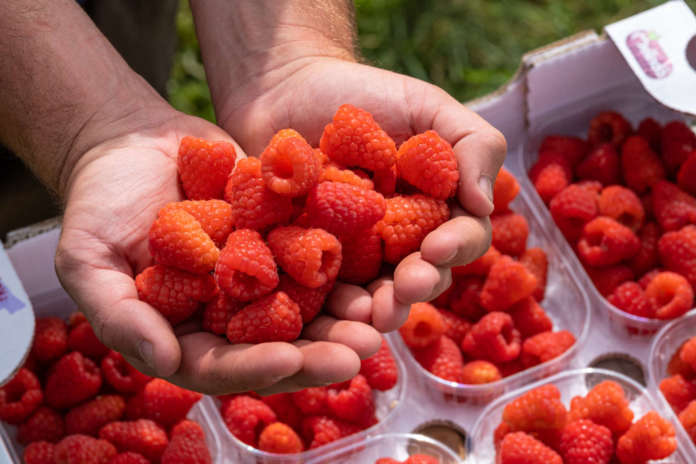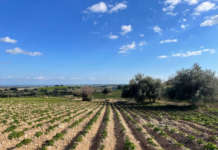Dopo anni di crescita trainata dal trend salutistico rallenta la domanda per lamponi e fragole, mentre non conosce arresto quella per il mirtillo, considerato sempre più un superfood. Crescono le superfici di coltivazione in Italia (in particolare mirtilli e more al Nord, lamponi al Sud), ormai oltre i 2000 ettari. Attivi programmi di ampliamento e nuovi siti produttivi, da nord a sud del Paese, con l’applicazione di tecniche di coltivazione che hanno permesso di estendere la raccolta fuori stagione. Nonostante l’aumento della produzione dipendiamo ancora dalle importazioni che tendono a salire, in primis mirtilli e lamponi da Spagna e Cile. La grande distribuzione domina le vendite, mentre soffre il canale tradizionale e i piccoli. A livello commerciale, premiano le strategie di valorizzazione del prodotto italiano e i progetti di category management da parte dei player.
Il biologico, pur in crescita, vede un rallentamento e una rappresentatività marginale nel punto di vendita (quasi esclusivamente mirtilli e lamponi). Gli acquisti (337 tonnellate contro le 13 mila del convenzionale) rappresentano una piccolissima quota del totale (2,5 %) così come la penetrazione che riguarda solo il 2% delle famiglie italiane.
Rallenta in trend di crescita dei consumi, bene i mirtilli soffrono lamponi e fragole
Dopo il boom registrato nel corso della pandemia, – dove si è passati dalle circa 6 mila tonnellate del 2016 alle oltre 13 mila del 2022 – gli acquisti appaiono in evidente rallentamento anche se la crescita continua a persistere a ritmi meno sostenuti (+3% pari a circa 346 tonnellate in più sul 2021). Nell’ambito dei piccoli frutti sono i mirtilli a guidare la classifica dei consumi con il 66% delle quantità acquistate nel corso del 2022 e oltre 8.000 tonnellate, mentre al secondo posto si attestano i lamponi con il 14% l’equivalente di 1.800 tonnellate, varietà in sofferenza rispetto a qualche anno fa dove la quota arrivata anche al 20%. Le more, in sofferenza come referenza, si attestano sulle 540 tonnellate e sono al terzo posto con il 3% dei volumi totali, così come i ribes che registrano 420 tonnellate di acquisti. Infine il complesso di tutte le altre specie con 1.700 tonnellate, tali da accentrare il 13% dei volumi totali. Bene, ma non troppo, anche l’indice di penetrazione della categoria che è salito fino al 30% per il 2021 ed attualmente si attesta intorno al 29% e il volume di prodotto consumato per singolo nucleo passato da 1,25 kg per il 2016 agli attuali 1,82 kg così come la spesa per famiglia acquirente che raggiunge i 22,57 euro.
Un dato, quello sulla penetrazione della categoria, che rivela potenzialità inespresse e un’insufficiente conoscenza del consumatore che, se educato e informato, potrebbe aumentare il consumo
I piccoli frutti piacciono prevalentemente al Nord, con il 55% delle quantità acquistate- circa 7.310 tonnellate, mentre al Sud (20%) e nelle Isole, sembra esserci meno interesse.
Canali distributivi: grande distribuzione in crescita, perdono quote altri canali
La grande distribuzione ha il dominio sulle vendite con quasi il 90% delle quantità totali – 12 mila tonnellate circa in valori assoluti. Un primato dovuto principalmente alla capacità di mantenere la catena del freddo necessaria per la conservazione del prodotto. La parte da leone la fanno i supermercati che nel corso del 2022 hanno trattato il 56% dei volumi totali con oltre 7.500 tonnellate, seguita dai discount con il 19% dei volumi con circa 2.500 tonnellate in costante crescita (+10%).
Gli ipermercati con il 12% delle quote nazionali pari a 1.660 tonnellate chiudono la classifica anch’essi con un importante incremento pari al +8% rispetto al 2021.
Rimangono marginali superette, piccole superfici e canali tradizionali che ricoprono quantità decisamente ridotte insieme ai mercati ambulanti o rionali che scendono al 5% delle quote sul totale a volume acquistato nel corso del 2022 (624 tonnellate il -27% sul 2021). I fruttivendoli con il 5% e 680 tonnellate perdono il -26% sull’anno. Per quanto riguarda le modalità di vendita, il prodotto è acquistato prevalentemente confezionato – 92% nel corso del 2022 –e questo sottolinea l’importanza di un packaging accattivante e coerente con il messaggio salutistico che si vuole trasmettere con il prodotto.
Il punto sulla ricerca
Tante le novità in termini di ricerca genetica, materiali innovativi per la produzione in serra e prodotti per la difesa e la crescita delle piante.
I cambiamenti climatici in corso impongono la produzione di cultivar con una maggiore adattabilità ambientale, in particolare quelle che prima richiedevano climi freddi. Programmi di breeding e caratteristiche chiave per il consumatore (gusto, croccantezza e consistenza in particolare) sono i due filoni su cui si sta muovendo la ricerca, iniziata ormai da 12 anni, della Fondazione Edmund Mach di San Michele all’Adige (TN).
Per il mirtillo, in particolare, presso l’Istituto di ricerca trentino si sta lavorando, in collaborazione con la North Carolina University (progetto VacCAP), sul mirtillo americano (Vaccinium corymbosum) ibridato con diverse specie provenienti dalla Florida che hanno portato, nelle specie del nord, a cultivar che necessitano di temperature meno fredde.
Le strategie per il comparto
Il mercato dei berries è estremamente affollato e il consumatore si trova disorientato di fronte ad uno scaffale in cui il prodotto estero difficilmente si distingue da quello italiano.
Per distinguersi i player puntano sul prodotto nazionale, forniture continue tutto l’anno, prodotti a residuo zero, packaging riciclati e riciclabili, packaging attivi per allungare la shelf life, progetti di category management.
La Grande Bellezza Italiana, la rete d’imprese che raccoglie oltre mille ettari produttivi tra Veneto, Piemonte, Emilia Romagna e Puglia, punta sull’italianità delle produzioni, sugli aspetti legati alla sostenibilità ambientale per il packaging (tra i primi ad utilizzare vassoi in fibra di legno, flowpaccati in PLA e etichette in carta) e su confezioni che rendono il banco frigo e il reparto ortofrutta attraente ed elegante.
Leonardo Odorizzi, socio e fondatore del gruppo, sostiene che il momento è favorevole per le eccellenze italiane e che, per i piccoli frutti, il consumatore abbia necessità di scegliere. “Per mirtilli e lamponi, la filiera del Piemonte è strategica per noi in quanto le produzioni dei nostri soci rispondono perfettamente alle nostre esigenze che impongono standard di territorialità e di qualità”. In prima linea anche Spreafico con importanti investimenti in ricerca e accordi produttivi con ben 95 aziende nazionali distribuite in undici regioni per un totale di circa 150 ettari.
Il Gruppo è impegnato nel rafforzamento della filiera italiana (il prodotto viene consegnato e confezionato direttamente nei due stabilimenti di Verona e Latina) per offrire al mercato un prodotto nazionale di qualità lungo tutto l’anno. Inoltre, per garantire la continuità delle forniture, importa dalla filiera produttiva estera di almeno 15 paesi. Alla categoria ha dedicato una propria linea, iPiccoli, volta a migliorare la visibilità e la presenza dei berries all’interno dei punti vendita.
La cooperativa trentina Sant’Orsola, attiva nel mercato dei berries da oltre 40 anni, punta sul residuo zero per mirtilli e lamponi, terza via tra la produzione a lotta integrata e il biologico. Certificato da un ente terzo indipendente, Il mirtillo residuo zero di Sant’Orsola è un prodotto 100% italiano coltivato da marzo a settembre in Calabria, Marche, Sicilia e Trentino.
Consolida la propria posizione nel comparto dei berries anche il Consorzio della Val di Non Melinda che aumenta le proprie potenzialità logistiche destinando ai piccoli frutti una sala di lavorazione dove, da luglio a ottobre accanto alle ciliegie, verranno lavorati mirtilli con volumi complessivi previsti pari a 200 tonnellate, lamponi (100 tonnellate), more (70 tonnellate) e ribes (30 tonnellate).
Anche Solarelli con Chicche di Natura, marchio nato dalla sinergia tra Apofruit Italia, Coop Sole e Ortofruit Italia, dedica alla categoria un brand specifico. Il progetto, che contraddistingue lamponi, mirtilli, more, ribes, fragole, ciliegie, kiwiberry nergi, uva senza semi bianca, rossa e nera, propone le referenze fresche direttamente in pratici bicchieri che consentono un consumo on the go, e in cestini, per il consumo a casa.
Coop Sole punta sulla fascia premium per le fragole, lavorando sulla scelta varietale, processo produttivo (filiere corte che vanno dalla raccolta al condizionamento immediato del prodotto) e un packaging accattivante e compostabile oltre a fornire prodotti da agricoltura biologica. Continua, infatti, il successo del progetto Si Bon per le fragole con referenze che si fanno notare a scaffale.
Si punta sull’innovazione varietale anche in casa del Gruppo SanLucar, marchio premium globale per il settore ortofrutticolo con filiali in diversi paesi europei, con iniziative che coinvolgono la produzione ma anche il mercato. Il gruppo ha varietà in prova in 19 paesi e collabora con diversi breeder a livello globale. Ciò comporta notevoli investimenti – non meno di 5 anni prima di portare una varietà sul mercato – ma i risultati compensano l’attesa avendo la disponibilità di prodotti in esclusiva.
Mirtilli, un fenomeno in crescita a livello mondiale
Tra i berries è il prodotto che registra le migliori performance in termini di crescita, tanto da registrare un + 35% a livello globale e un incremento dei consumi in Italia del + 9,7% nel 2022.
La crescita media produttiva mondiale tra il 2021 e il 2022 si è attestata tra il 10 e il 15%, legata allo sviluppo di nuove varietà capaci di adattarsi a tutte le latitudini. Tra le nuove tecniche colturali spicca l’introduzione di produzioni fuori suolo
Gli esperti indicano in 2 milioni di tonnellate (fonte International Blueberry Organization) il consumo mondiale di mirtillo entro i prossimi dieci anni, con un acquisto medio nell’area europea di 860 grammi pro capite entro il 2026
Le previsioni positive hanno spinto gli investimenti e l’ampliamento delle aree di coltivazione in tutta Europa compresa l’Italia, che vede un progressivo aumento delle aree di coltivazione nel Sud, in particolare Sicilia, Calabria oltre ai già vocati Trentino e Piemonte.
In Europa bene la Turchia che punta alle 100 mila tonnellate di prodotto da esportare nei prossimi anni ed è unanimemente considerato uno dei paesi emergenti insieme alla Georgia.
Cina, Stati Uniti e Perù (primo esportatore mondiale) restano i leader mondiali, anche se la partita rimane aperta data l’imponente crescita di competitor quali Messico e Sudafrica.
In Europa il podio rimane alla Spagna, ma Portogallo e Polonia, che nel frattempo ha triplicato i volumi diventando il principale fornitore della Germania, rimangono dietro di poche lunghezze.
In Italia, il prodotto piace ai consumatori, che aumentano gli acquisti dell’1,6% nel 2022, ma fa gola anche alla GDO grazie alla disponibilità del prodotto per 52 settimane all’anno, all’aumento della shelf life (anche fino a 60 giorni) e a linee premium che puntano su dimensioni e grado brix.
A livello globale tiene banco iI tema del rinnovamento varietale che sta interessando sia il Perù che il Cile, che sta ridisegnando le proprie strategie di produzione ed esportazione del mirtillo per fare fronte alle nuove sfide. Ad oggi le quantità in esportazione di mirtillo fresco cileno sono in calo del 20% (stagione 2022/23), da 110.000 tonnellate a 87.000 mila tonnellate. Rimangono le criticità della logistica, della scarsità di manodopera e dei cambiamenti climatici, a cui si aggiunge la concorrenza dei nuovi paesi produttori che sta rapidamente erodendo le quote di mercato globali del mirtillo cileno, tra cui principalmente Perù. •
—–
Out of season harvest, too for berries
Enhancement strategies of the Italian product and category management projects carried out by the players are rewarding
After years of growth driven by the health trend, the demand for raspberries and strawberries is slowing down, while the one concerning blueberries, increasingly considered a superfood, does not stop. Cultivation surfaces in Italy are growing (in particular blueberries and blackberries in the North, raspberries in the South), and now we are talking about over 2000 hectares. Active expansion programs and new production sites, from north to south of the Country, with the application of cultivation techniques, have made it possible to extend the harvest out of season.
Despite the increase in production, we still depend on imports, which tend to rise, primarily for blueberries and raspberries from Spain and Chile. Large-scale distribution dominates sales, while the traditional channel and the small ones are suffering.
At a commercial level, enhancement strategies of the Italian product and category management projects carried out by the players are rewarding.
The organic sector, although growing, sees a slowdown and a marginal representation in stores (almost exclusively blueberries and raspberries). Purchases (337 tonnes against 13,000 for conventional products) represent a very small share of the total (2.5%) as does the penetration, which concerns only 2% of Italian families.
Consumption growth trend slows down, blueberries are going well, raspberries and strawberries are suffering
After the boom recorded during the pandemic – where sales went from about 6 thousand tonnes in 2016 to over 13 thousand in 2022 – purchases appear to be clearly slowing down, even if growth continues to persist at a slower pace (+3%, that is to say about 346 tonnes compared to 2021).
In the domain of small fruits, blueberries lead the consumption ranking, with 66% of the quantities purchased in 2022 and over 8,000 tonnes, while raspberries are in second place with 14%, the equivalent of 1,800 tonnes, suffering variety compared to a few years ago, when their share even reached 20%.
Blackberries, suffering as a reference, amount to 540 tonnes and are in third place with 3% of the total volumes, as well as currant, which records 420 tonnes of purchases.
Finally, there is the complex of all the other species with 1,700 tonnes, such as to centralize 13% of total volumes.
The penetration index of the category, too, is going well, but not too much, as it rose up to 30% for 2021 and currently stands at around 29% and the volume of product consumed per single nucleus increased from 1.25 kg in 2016 to the current 1.82 kg, and the same happens for the expenditure per purchasing family, which reaches 22.57 Euros.
The figure concerning the penetration of the category reveals unexpressed potential and insufficient knowledge by the consumer, who, if educated and informed, could increase consumption.
Small fruits are appreciated mainly in the North, with 55% of the quantities purchased – around 7,310 tonnes – while in the South (20%) and in the Islands, there seems to be less interest.
Distribution channels: large-scale distribution is growing, other channels are losing shares
Large-scale distribution dominates sales with almost 90% of total quantities – around 12,000 tonnes in absolute values.
This record is mainly due to the ability to maintain the cold chain necessary for the preservation of the product.
The lion’s share goes to supermarkets, which in 2022 handled 56% of total volumes with over 7,500 tonnes, followed by discount stores, with 19% of volumes, and around 2,500 tonnes in constant growth (+10%).
Hypermarkets, with 12% of the national quotas, that is to say 1,660 tonnes, close the ranking with a significant increase of +8% compared to 2021.
Superettes, small surfaces, and traditional canals remain marginal, covering decidedly reduced quantities together with itinerant or street markets, which dropped to 5% of the shares on the total volume purchased in 2022 (624 tonnes, -27% compared to 2021). Greengrocers with 5% and 680 tonnes are losing -26% during the year.
As regards the methods of sale, the product is mainly purchased packaged – 92% during 2022 – and this underlines the importance of an attractive packaging, consistent with the health message that the seller wants to convey with the product.
The point on research
Many news concern genetic research, innovative materials for greenhouse production, and products for the defence and growth of plants.
Ongoing climate changes require the production of cultivars with greater environmental adaptability, particularly those that previously required cold climates.
Breeding programs and key characteristics for the consumer (taste, crunchiness, and texture in particular) are the two lines on which the research, which began 12 years ago, carried out by the Edmund Mach Foundation at San Michele all’Adige (Trento), is moving.
For blueberry, in particular, the Research Institute is working, in collaboration with the North Carolina University (VacCAP project), on the American blueberry (Vaccinium corymbosum) hybridized with various species from Florida which have led, in the species of the north, to cultivars that need less cold temperatures.
Strategies for the sector
The berry market is extremely crowded and the consumers find themselves disoriented in front of a shelf where it is difficult to distinguish foreign products from Italian ones.
To distinguish themselves, the players focus on national products, continuous supplies all year round, zero-waste products, recycled and recyclable packaging, active packaging to extend shelf life, category management projects. La Grande Bellezza Italiana, the network of companies that gathers over a thousand productive hectares between Veneto, Piedmont, Emilia Romagna and Puglia, focuses on the Italian character of its productions, on the aspects related to environmental sustainability for its packaging (among the first to use trays in wood fibre, flow-packed products in PLA, and paper labels) and on packages that make the refrigerated counter and the fruit and vegetable department attractive and elegant. Leonardo Odorizzi, partner and founder of the group, argues that the moment is favourable for Italian excellence and that, for small fruits, the consumer needs to choose. ‘For blueberries and raspberries, the supply chain of Piedmont is strategic for us, as the productions of our members respond perfectly to our needs, which impose standards in terms of territoriality and quality’.
Spreafico, too, is at the forefront with important investments in research and production agreements, with as many as 95 national companies distributed in eleven regions for a total of about 150 hectares.
The Group is committed to strengthening the Italian supply chain (the product is delivered and packaged directly in the two plants in Verona and Latina) to offer the market a quality national product throughout the year. Furthermore, to ensure the continuity of supplies, it imports from the foreign production chain of at least 15 Countries. It has dedicated its own line, iPiccoli, to the category of small fruits, aimed at improving both visibility and presence of berries in the stores.
Sant’Orsola cooperative in Trentino, active in the berry market for over 40 years, focuses on zero residue for blueberries and raspberries, the third way between integrated pest management and organic production. Certified by an independent third party, Sant’Orsola’s zero residue blueberry is a completely Italian product grown from March to September in Calabria, Marche, Sicily, and Trentino.
‘Consorzio della Val di Non Melinda’ Consortium is also consolidating its position in the berry sector, increasing its logistical potential by allocating a processing room to berries, where, from July to October, blueberries will be processed alongside cherries, with a total expected volume of 200 tonnes, raspberries (100 tonnes), blackberries (70 tonnes), and currants (30 tonnes).
Solarelli with Chicche di Natura, a brand born from the synergy between Apofruit Italia, Coop Sole and Ortofruit Italia, also dedicates a specific brand to this category. The project, which distinguishes raspberries, blueberries, blackberries, currants, strawberries, cherries, nergi kiwiberry, white, red and black seedless grapes, offers fresh references directly in practical glasses that allow consumption on the go, and in baskets, for consumption at home.
Coop Sole focuses on the premium range for strawberries, working on the choice of varieties, production process (short supply chains ranging from harvesting to immediate conditioning of the product) and attractive and compostable packaging, as well as supplying products from organic farming. In fact, the success of Si Bon project for strawberries continues with references that stand out on the shelf.
The focus is on varietal innovation for SanLucar Group, too, a global premium brand for the fruit and vegetable sector with branches in various European Countries, with initiatives that involve production, but also the market. The group has some varieties on test in 19 Countries and collaborates with several breeders globally. This requires considerable investments – no less than 5 years before bringing a variety to the market – but the results compensate for the wait by having exclusive availability of products.
Blueberries, a growing phenomenon worldwide
Among berries, it is the product that records the best performance in terms of growth, so much so that it is recording + 35% globally and an increase in consumption in Italy by + 9.7% in 2022.
The average world production growth between 2021 and 2022 stood at between 10 and 15%, linked to the development of new varieties capable of adapting to all latitudes. Among the new cultivation techniques, the introduction of soilless productions stands out.
Experts indicate the world consumption of blueberries at 2 million tonnes (source International Blueberry Organization) within the next ten years, with an average purchase in the European area of 860 grams per capita by 2026.
The positive forecasts have prompted investments and the expansion of cultivation areas throughout Europe including Italy, which sees a progressive increase in cultivation areas in the South, in particular in Sicily and Calabria, in addition to the already suitable Trentino and Piedmont.
Turkey is doing well in Europe, aiming for 100,000 tonnes of product to be exported in the coming years and is unanimously considered one of the emerging Countries together with Georgia.
China, the United States and Peru (the world’s leading exporter) remain the world leaders, even if the game remains open, given the impressive growth of such competitors as Mexico and South Africa.
In Europe, Spain is still the leading Country, but Portugal and Poland, which in the meantime has tripled its volumes by becoming the main supplier of Germany, remain behind by a few lengths.
In Italy, consumers appreciate the product and their purchases increased by 1.6% in 2022, but the product itself is also interesting for large-scale distribution, thanks to the availability of the product for 52 weeks a year, the increase in shelf life (even up to 60 days), and premium lines that focus on size and brix degree.
At a global level, the theme of varietal renewal holds court. It is affecting both Peru and Chile, which is redesigning its blueberry production and export strategies to face the new challenges. To date, the export quantities of fresh Chilean blueberry are down by 20% (2022/23 season), from 110,000 tonnes to 87,000 thousand tonnes.
The critical issues of logistics, labour shortages and climate change remain, and the competition from new producing Countries, which is rapidly eroding the global market shares of the Chilean blueberry, mainly Peru, must be added.










